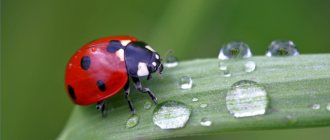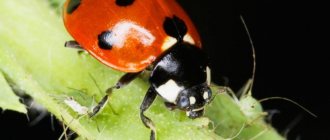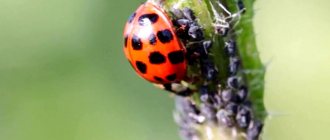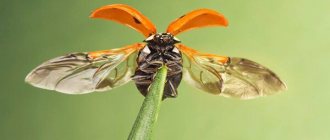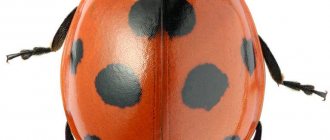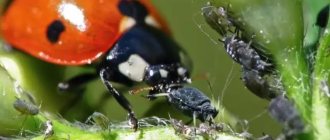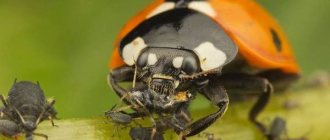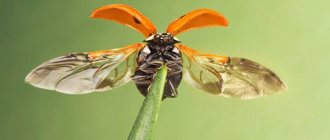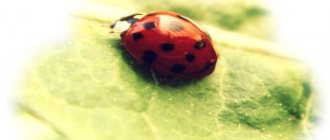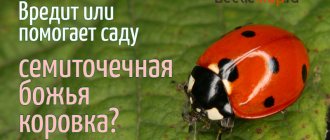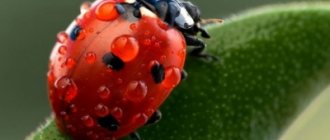- September 15, 2018
- Tips for tourists
- Anisimova Svetlana
This small cute bug, which lives throughout the Earth, is called “ladybug” in Russia. Why did they call him that? Despite the fact that its name sounds different in other countries, it is necessarily associated with God or the Mother of God. Its simple bright coloring attracts the human eye. Children especially love him. It is not for nothing that toys depicting this beetle are made for the little ones.
Ladybug beetle. Why is it called that?
In Russia everywhere, this little bug is associated with many beliefs and legends that explain the name. If a “ladybug” lands on you, then you should not be afraid. It was believed that these bugs live in the sky and are harbingers of good events. They fulfill the mission of God's messengers, and therefore require respectful treatment. They cannot be offended, much less killed, as this can bring misfortune.
There is another belief why the “ladybug” is called “ladybug”. If you want to convey your message to heaven, then during the time that the “ladybug” is sitting on your right hand, where it must be transplanted if you find it on yourself, and has not flown away, tell her about your request or dream. She will definitely pass it on to God and perhaps your wish will be fulfilled. It is interesting that similar legends exist among almost all European peoples, so it is not surprising why the “ladybug” is called that. She is treated with sympathy and is certainly associated in some countries with God, in others with the Mother of God.
Benefits and harms
The benefits of the ladybug, especially in our latitudes, are undeniable; the principle “the enemy of my enemy is my friend” works here. Ladybugs, by eating various insect pests, provide a great service to agricultural lands. Sometimes they are even specially bred in special places and then sprayed over fields and plantations infested with pests.
But among them there are also herbivorous species, most of them live in tropical areas, which can also harm agricultural crops.
"Ladybug" in Slavic mythology
It is well known that the ancient Slavs deified the nature that surrounded them. Therefore, one legend says that the Sun God Perun, angry with his wife for betrayal, punished her by turning her into a red bug. But even after this, the anger was so great that he could not calm down and began to throw fiery arrows after the flying beetle. Their sparks left black round marks on the red wings.
But the wife of God Perun does not give up hope for her forgiveness. Therefore, he delivers messages from people to him and brings them good news from the ancient pagan God. This legend gives a clue why the "ladybug" was called "ladybug". Her appearance evokes positive emotions and trust in this lovely creature. She is not afraid to trust her with your dreams and desires.
Reproduction and development stages
Ladybugs reach sexual maturity, depending on the species, at 3-6 months of life. Their mating season begins in the spring. The male finds his chosen one by the characteristic smell that she emits during that period. A short time after mating, the female ladybug lays eggs, and often acts very wisely, laying them near aphid colonies in order to immediately provide future offspring with food.
Ladybug eggs are attached to the underside of the leaves; they are oval in shape with slightly tapered ends. There are up to 400 eggs in one clutch. Unfortunately, the females themselves die soon after laying eggs.
After 1-2 weeks, variegated ladybug larvae emerge from the eggs. They have an oval or flat shape. The surface of the larva's body is often covered with thin bristles or hairs. In the first days of their lives, they eat the shell of the egg from which they hatched, then neighboring eggs without or even with embryos (yes, ladybug larvae can be cannibals). Gradually gaining strength, they begin to eat the aphid colony.
The future ladybug remains in the larval state for 4-7 weeks, after which the pupation stage begins. The pupa is attached to a leaf of the plant and in this position, in the cocoon, spends 7-10 days; it is during this period that all body parts characteristic of a cow are formed. After this period, a fully formed adult appears.
Cute predator - “ladybug”
Many people imagine this beetle as a harmless herbivore, however, it is a real predator. Scientists have calculated that it eats 50 aphids per day, and its larva eats up to 800 during its development. This is a real aphid exterminator. Experienced gardeners know the damage this pest causes to many garden and garden plants.
The French breed these beetles on farms. You can actually buy them in special stores or even receive them cash on delivery by mail. A couple of ladybugs are enough to clean a rose bush. Why is this beetle called that? Maybe because it helps preserve the crops grown that feed people. He is valued in the same way as a cow, which is the breadwinner of an entire family. This is where the name comes from.
From the life of “ladybugs”
The food for these beetles is aphids, whose life period lasts from early spring until the first autumn frosts, as well as other small insects. The duration of activity of the “ladybug” lasts as long as there is food. In the fall, these beetles crawl under fallen leaves or stones and sleep until spring. Their lifespan depends on the availability of food and can range from several months to a year. But under favorable conditions it can be two years.
Young and old beetles can be distinguished. The fact is that young individuals have brightly colored hard wings. It fades with age. The bright color is not accidental and is intended to warn those who want to encroach on its life that it is poisonous. When meeting a predator, it secretes a kind of “milk” - an odorous and poisonous liquid. Here is another version of why the “ladybug” was called that.
Interestingly, birds do not hunt “ladies”; their main enemies are spiders and frogs, from which they try to fly away. When flying, the wings flap up to 85 beats per second.
Nutrition
Most ladybugs are predators. Both larvae and adults feed on insects, including:
- aphid;
- caterpillars;
- scale insects;
- spider mites;
- eggs of butterflies and Colorado beetles;
- insect larvae.
Bugs do not hunt in the literal sense of the word. They do not ambush prey or set traps. The ladybug slowly crawls through the plant until it comes across something it can eat.
Representatives of several species eat exclusively plant foods: leaves, flowers and fruits, pollen, mushroom mycelium.
Do they feed in their natural environment in winter?
In winter, insects have no need for food: they either sleep or are in a state of suspended animation. Over the summer, sugar and glycerin manage to accumulate in their tissues. In order not to burst from the temperature drop when cold weather sets in, they have to remove a large amount of fluid from the body.
The ladybugs' task at the moment is to find warm places for wintering. A large number of insects can group together for these purposes in one place. Ladybugs usually prefer dry leaves, bark or window cracks as shelters.
But you should always remember: for such a small predator, a huge human hand poses a serious danger. Do not rush to completely plow the area, or spray the garden with poisons - you will lose your tiny helpers forever.
Variety of "ladybugs"
Above we talked about the “ladybug”, which has seven black dots on its red wings. It is this species that feeds on aphids and is widespread throughout Russia and Europe. But in nature, scientists have counted more than 400 species, among which there are real pests. Not all beetles included in this species are predators; there are those that feed on plant foods.
They may have different places of residence. Some live in trees, others in meadows on grass, shrubs, coastal grasses and reeds. Ladybugs are pests that live in subtropical Africa and Southeast Asia. In the Russian Far East, a serious danger is posed by the “ladybug”, which is colored yellow and has 28 black dots. It causes serious damage to potato and tomato crops.
So, of all the representatives of Coccinellidae, only the familiar and so cute red-orange bug with seven dots on its wings, which saves our gardens from aphids, ticks, fleas and scale insects, can be called a “ladybug”.
Types, photos and names
Zoologists identify 4,000 different species of ladybugs, divided into 7 subfamilies. We will describe the most interesting among them.
Two-spot ladybird
This is a beetle with a body length of up to 5 mm, with a dark red body and two black dots (hence the name).
Seven-spotted ladybird
It is this type of ladybug that is most common in Europe. Its size is 7-8 mm. Its elytra are painted red, there are three black spots on the sides, and the seventh is located near the head of the insect.
Twelve-spotted ladybug
This ladybug has a length of 6 mm, a bright pink or red color, and, accordingly, 12 black spots on the elytra.
Thirteen-spotted ladybird
This type of ladybug has as many as 13 spots against the background of red-brown elytra; some of its spots can merge with each other.
Asian ladybug
This ladybird is up to 7 mm long and is divided into two subspecies. One of them has a yellow wing cover with black spots, both large and small. The second subspecies is characterized by black coloration of the elytra, on which red-orange spots are visible.
Ocellated ladybird
This is a very large representative of the ladybird family, reaching up to 10 mm in length. It has red or yellow elytra and black spots surrounded by lighter rims.
Pointless ladybug
This is a very rare species; its characteristic feature is the absence of signature spots. Also, the red or brown body of the pointless ladybug is covered with small fibers.
Blue ladybug
This is another unusual member of the ladybug family, having a characteristic blue color. Such insects live exclusively in Australia.
